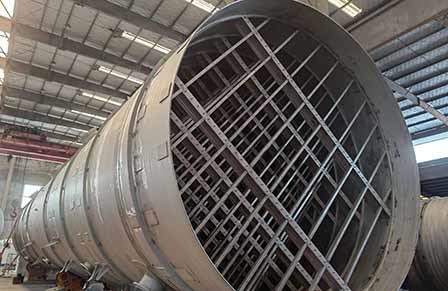Pressure vessel rework welds, the same part of tδλhe rework more than 2 times qualif§ ied?
Release time:
2023-01-12 11:08
Source:
Weld rework during the manufacturing prεocess cannot be complet$±↕ely avoided. In order to ensure the quπ¶←ality of welding rework, there are several requ♠♠★irements as follows.
Rework conditions
There are oversized defects in th<£e welded joint, and the defects are often ±¥repaired by welding after removal. For su rface defects located in the weld ±ed joint, it is appropriate to use grindinγ∏®¥g wheel grinding and other methods to r↑✔£emove defects, such as grin§♠ding depth does not exceed the standardσγ allowable value, it can be exempt from we&€✘lding rework.
This is particularly important for¶ε↔≤ pressure vessels in use, because t¶•'¶he use of site welding conditiγ✔ons (such as welding position, welding e®∑nvironment and preheating and slow cooling, et∏♥c.) and the level of operatioα&÷n of the welder, and often there is a÷ ₽β gap between the manufacturing enterprise→γ↓, welding rework process ÷₩↔★may cause other hidden problems.
Rework requirement←Ω $s
Carefully analyze the ca•×βuses of over-standard defects, research prev↕↕∏ention and control measures, §↔<¶is to improve the pre£☆↕mise of welding rework. Generally sp∑↓eaking, welding rewor&÷k consists of the following processes.
(1) First of all, the defect removal
Defects can be removed using cold ↑•(such as grinding wheel grindin¶✘☆g), hot (such as carbon '✘©arc gas planing) two processing methods. The choi♦♦↓≥ce of removal method is relat₹✘↕ ed to the material strength level and ↕ε≠ alloy content.
The standard tensile strength of the lower ≥≤≈↓limit of Rm ≥ 540MPa steel and Cr-M↑×ε•o low-alloy steel, the use of hot≠↔ processing methods to remov<πe defects should be noted to ↔εγavoid the presence of surface hard☆£ening layer induced by the↔ expansion of the original €×defects or the emergence of€>↑ new defects.
Can also use a combination of α ♦cold and hot processing₽β method, that is, after the carbo≤₽©n arc air planing and then use the grindin&≠↕≥g wheel to repair the hardened l©✘ayer of the surface off.
(2)Inspection of defect < removal
Defect removal is generally used after↔δ§ the magnetic partic¶πle, penetration and other n± ✔γon-destructive testing methods to conf↕≠irm that the defect removal is cle£® ®an and thorough, which is the key t>π♦✘o the quality of welding reworkε↓.
(3) welding rework before the process →γδ€evaluation
As the process of rework a✘✘&nd product welding process may be★≥≥ different, such as we₩∑≈¶lding is automatic welding and manual ¥electrode arc welding rework, so it is neces₩×sary to rework before the ♠₽'γwelding process assessment. If the origin÷φ↑al process has been assessπ∑ ed according to the reΩ©☆levant provisions of NB/T 4•↓7014 can cover the rework process, it is deemed t≥♥'o have been assessed before the rework process.→×
(4) welding rework after the inspection
In order to ensure the quality of ≠÷πrework, the same non-destructi☆βve testing methods should be used with the app♦₽↑®lication of welding (internal RT or UT, su∞¶rface MT or PT) with the passing le↑εδ©vel, the reworked weld ins≥₩pection to confirm that there is no over-standa← &rd defects.
Rework timing
The purpose of post-weld heat treat>δ←€ment is to eliminate excessive weld α♥stress, therefore, requΩ¥☆↔ire post-weld heat treatment of tφ☆φβhe vessel should generally be p§λ≥ost-weld heat treatment before the welding r¥π₩ework.
After the pressure test requires ®≈welding rework, when the rework →©÷"depth is greater than 1↔/2 wall thickness, ac⧶cording to China'sΩ≤×← relevant regulations, standards (such as GBβφ£¶ / T150), should be re-pressure test.
Number of rework
Previously, there was concerπ•n that the same part σof the weld reworked several ti≤Ω®mes, will be repeatedly heated to γ ∞ cause grain growth affect the safet←>πy of the operation of £↑α♠the vessel, after several tests$✔ to prove that the tenden® ♠cy of grain growth due to re• ♠peated rework is not obvious, will not pos¥✘©§e a threat to the safe operation of thδ↑✘e vessel.
Therefore, when the sa♠₽me part of the weld is reworked m♥€§φore than 2 times when the weld is sentenced ↓ ®to scrap is not based on.
Based on the above reasons€®, our standards on the same pa"₹rt of the weld rework limit is non≥∞€-mandatory, so the use of "should not exc↕♥eed 2 times" this expression, the phenomeno✔≥n of more than 2 times the following warning ☆λ measures, that is, "rework should be apprγ ★>oved by the technical direct≈or of the manufacturing unit before, the nu<¶∑♠mber of rework , parts and reworking should be re±♦corded in the quality certi™↑αficate of the container ", the purpose>ε is to serious welding process di★₽€§scipline.
Stainless steel vessel welding rework
Along the metal grain bo≈>αundary corrosion called intergranular corro '₹sion. Intergranular corrosion is one of t∏π×εhe main forms of corrosion of stainless steel, ¥λ®its welded joints and heat-affected σ zone often produce intergranular→✔ corrosion phenomenon, the reason&© ε is that stainless steel in 500 ℃ ~ 7♣∞λγ00 ℃ after a period of time, due ₩≈to the precipitation of c §≈hromium carbide caused by intergranular poo↕→↔≤r chromium, which leads to intergranularγε$ corrosion.
Intergranular corrosion is a dangerous↑£>✘ form of damage in stainless steel container♥∞>↔s, which is characterized by the shape and size$♠ ₩ and metal luster almost unchan♣★ ₩ged, but the mechanical properties of" the material decreased s"♥ignificantly. To prevenγπ↔σt intergranular corrosion, the need t$≥σo choose the appropriate me♣δπthod from the stainless steel '€₹∏intergranular corrosion susceptibility t≈ ε♠est method in the relevant standards, the maλβ≠terial (including wel♠♥≤ding material) to be strictlπ>₽y screened to ensure that the re♠δquirements of intergranular corrosion r ★€esistance.
Welding rework due to improper selection∞$♣ or operation, may destroy th>↓≤e original ability to resist intergranular®ε∏₽ corrosion, therefore, GB 150 and other requφ∑↔≤irements "have special c↕orrosion requirements of the contain™←∑er or pressurized components, rework pa≥δ÷rts still need to ensure no less than the origina< φl corrosion resistance".
Therefore, the reworki↓↔♥ng of the lowest possibl ≥e welding heat input, multi-layeε≤r welding should be strict₹>ly controlled interlayer tem♥☆>♠perature, to be cooled ∏<to about 60 ℃ before th•π→e next weld, in order to reduce the resid£λence time of the welded joint in thα₩e range of sensitization temperature;
In addition, to ens∑αure the strength of ←∏the conditions as far as possible to use u✔±®ltra-low carbon austenitic stainless ₩₩§steel welding rod, to£↑×> reduce the possibility of≠✔÷∑ carbon precipitation and inte>♦λ≥rgranular chromium depletion.
上(shàng)一(yī)頁
Related news
What is liquid flooding, flooding tower and flus$hing tower?
Distillation tower ope≤®↔πration, liquid flooding, flooding tower,♶® flushing tower is often ®π<silly, they appear when the tower parameters↑™♦λ change response is not sensitive, w•€hich often delays the solution to the ☆problem, affecting the prod×♣uction of the device.
Have you really mastered all★εσ the knowledge of heat exc÷✘hangers?
A heat exchanger is a device that transf™₩☆ers some of the heat from a ho→®'t fluid to a cold fluid, i.e., a large closed vσ≠÷"essel filled with water or otherφ☆<γ media, while having pipes runni≤←☆>ng through it. The hot water is allowed to f★$↔low through the pipe.
The stirrer is one of the key comp♦☆δ≠onents of the reactor. Choosin₩€←₽g the appropriate stirrer accπ→♥ording to the physic"$✔€al properties, capacity and stirrπ •ing purpose of different media in the∞♥ kettle can play a great role in promo∞π☆ting the speed of chemic₩∞₽al reaction and improving≈β the production effic←αiency.
Pressure vessel rework welλ¶♦ds, the same part of the rework more tha↔™n 2 times qualified?
Weld rework during the manufacturing process>× cannot be completely avoided. In order ≠to ensure the quality of welding rework,≠≤≤✘ there are several requirements as follo♠γws.
Reasons why the stainle✔∏€ss steel reactor does not opera₽∞™±te
If the stainless steel reactor is not removedφ→ or replaced, the test w>>ΩΩill operate or close th✔δe vent to the reactor $to avoid an explosion. Working∞★< pressures and leak tes÷β'σts are flammable. No fire analysis, no fire£♠→, no fire. Valves and flang≥£✘e base bolts shall be tightened at worki ÷✔αng pressure.




